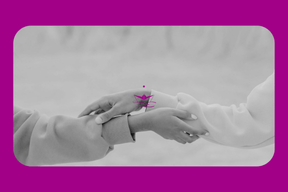The Thing Between Us
Touch is a concept that plays a very important role in our lives, yet it's not something we often reflect upon. In my dance experiences, I am fundamentally interested in exploring touch.
When we think of touch, the first thing that comes to mind is the word "touch," translated into English as such; however, “touch” doesn’t quite capture the full essence of what I mean by “contact.”
Touch is an action, a masculine (yang) element, something visible, while contact refers to the new energy that arises in the moment of connection — it is a state, a feminine (yin) aspect.
In fact, every time I touch, I’m not necessarily making contact. Therefore, calling every touch a form of contact is superficial. At the same time, it’s possible to make contact without physically touching. If I am truly present where I touch, if the one being touched also receives that touch — and I want to emphasize "receiving" here — and if a new energy emerges between us, then contact happens.
As humans, from the moment we are born, we are withdrawn from our most intense contact. In the womb, enveloped in the placenta, we are constantly in contact, and when we are born, we are deprived of that connection. It is well known that for a long time, we perceive ourselves as an extension of our mothers. Fortunately, the significant effects of contact, especially in our childhood, are now more widely understood and discussed.
There are numerous clinical studies on contact, such as the controversial twin experiments. For example, there was a study conducted with newborn babies. One group of babies was fed from a spoon without any physical contact, while another group was fed while being held close to the caregiver’s chest, receiving warm physical contact. When observing the development of these children, it was found that the babies who were fed without contact suffered serious health, psychological, and developmental issues.
My inquiries into contact began when I encountered somatic dialogue techniques. Bodily communication primarily involves exploring contact with oneself and with others. I remember how emotional I became when I first experienced somatic dialogue at the age of 18, and how hard it was to make sense of what I was feeling. What I experienced was very real, but invisible. When we send a message of contact to another person — whether through voice, sensation, gaze, touch, or intuition — we begin to weave an invisible thread between us.
“The real essence” is neither in me nor the other; the real essence lies in the spaces between us, in the bond that forms between us. This is what we call contact.
Contact is more than just touch; it is the state of being present together.
Carl Gustav Jung speaks of how a relationship is like a chemical reaction, and when contact occurs, both sides are transformed. “The meeting of two people is like the contact of two chemical substances: if there is any reaction, both are transformed.”
In the 21st century, creating moments of contact is quite difficult because contact requires simplicity, a capacity to just be there. At the same time, since contact inevitably brings transformation, it takes us out of our comfort zone. Contact requires courage. It demands the courage to face oneself and the other’s presence.
In today's world, the "cool" person is somehow someone who avoids too much contact.
I often mention these images imposed on us by popular culture in my talks. Loneliness had to be fitted with a certain facade, and now people can continue performing their patterns within their own solitary worlds, showcasing their personal truths.
Moreover, today, the word "contact" has taken on a completely different meaning. While we were already not reflecting on it, we have pushed its meaning into entirely new contexts. As the term has become so trivialized, I believe it’s important to repeatedly reconsider what it really means to be in contact.
In contact with ourselves or with others, what will awaken in our bodies is always a surprise; we can never know in advance which emotion, memory, future, or void it will lead us to. This unpredictability is the core of contact, the essence of life.
In this infinite unknown, I am trying to know myself.
Yet while trying to know myself, understanding that existence is more than just me — that it is about contact, about the space between us — is very precious. Indeed, as Tomris Uyar’s book title suggests, life is truly an experience of “The Thing Between Us.”


